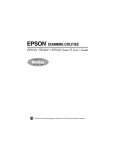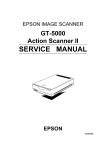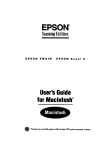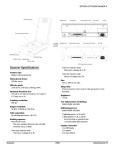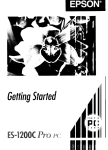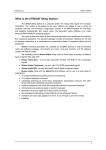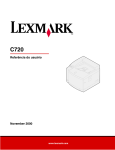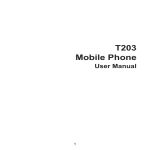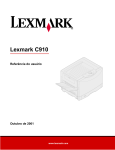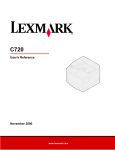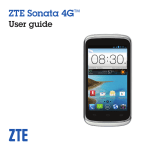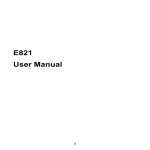Download Epson Stylus Color II User's Manual
Transcript
EPSON ® ACTION SCANNER™ II Color Scanner Getting Started for Windows @ Printed on recycled paper with at least 20% post-Consumer content A Note Concerning Responsible Use of Copyrighted Materials Like photocopiers, scanners can be misused by improper copying of copyrighted material. Although Section 107 of the U.S. Copyright Act of 1976 (Title 17, United States Code), the “fair use” doctrine, permits limited copying in certain circumstances, those circumstances may not be as broad as some people assume. Unless you have the advice of a knowledgeable attorney, be responsible and respectful by not scanning published material without the permission of the copyright holder. Copyright Notice All rights reserved. No part of this publication may be reproduced, stored in a retrieval system, or transmitted in any form or by any means, electronic, mechanical, photocopying, recording, or otherwise, without the prior written permission of Seiko Epson Corporation. No patent liability is assumed with respect to the use of the information contained herein. Neither is any liability assumed for damages resulting from the use of the information contained herein. Neither Seiko Epson Corporation nor its affiliates shall be liable to the purchaser of this product or third parties for damages, losses, costs, or expenses incurred by purchaser or third parties as a result of: accident, misuse, or abuse of this product or unauthorized modifications, repairs, or alterations to this product. Seiko Epson Corporation and its affiliates shall not be liable against any damages or problems arising from the use of any options or any consumable products other than those designated as Original EPSON Products or EPSON Approved Products by Seiko Epson Corporation. EPSON and EPSON Stylus are registered trademarks of Seiko Epson Corporation. ActionScanner is a trademark of Epson America, Inc. General notice: Other product names used herein are for identification purposes only and may be trademarks of their respective companies. EPSON disclaims any and all rights in those marks. Copyright © 1995 by Epson America, Inc. Torrance, California, USA 9/95 Contents Introduction . . . . . . . . . . . . . . . . . . . . . . . . . . . 1 System and Memory Requirements . . . . . . . . . . . . . 2 Installing the Parallel Interface Card . . . . . . . . . . . . . Configuring the Card . . . . . . . . . . . . . . . . . . . Installing the Card . . . . . . . . . . . . . . . . . . . . . 4 4 6 Setting Up the Scanner . . . . . . . . . . . . . . . . . . . . . 7 Connecting the Scanner to the Computer . . . . . . . . . . Configuring Parallel Port LPT2 for Windows 95 . . . . 9 10 Installing the EPSON Scanning Utilities . . . . . . . . . . . 11 Installing Image-In . . . . . . . . . . . . . . . . . . . . . . . 13 Scanning Images . . . . . . . . . . . . . . . . . . . . . . . . 15 Putting It Together . . . . . . . . . . . . . . . . . . . . . . . Calibrating Your System . . . . . . . . . . . . . . . . . . Selecting the Correct Resolution . . . . . . . . . . . . . 17 18 23 iii This package contains everything you need for professional quality color scanning: 0 EPSON© ActionScanner©II color scanner, which scans in full color (24 bit) or grayscale monochrome (8 bit) at 300 dpi (dots per inch) 0 Bidirectional parallel interface card, which provides an additional parallel interface for your computer cl Bidirectional parallel interface cable 0 EPSON Scanning Utilities (EPSON Scan! II and EPSON TWAIN), which let you capture scanned images, export the images in a variety of formats, calibrate your scanner, and use the scanner’s advanced features with software programs that support the industry standard TWAIN interface 0 Image-In® Easy Pack, a combination image-editing, optical character recognition (OCR), and file conversion program that lets you edit and retouch color images, convert hard copies into formatted text, and convert the files into a variety of formats. This booklet tells you how to set up your scanner, install the software, and scan an image. If you need more detailed information after you begin scanning, consult the individual manuals for the ActionScanner II, EPSON Scanning Utilities, and Image-In. System and Memory Requirements For the scanner hardware and software to work properly, your system must include the following minimum configuration listed below for either Windows 3.1 or Windows 95: Microsoft® Windows™ 3.1 Requirements: D A 386-based (or higher) IBM® compatible computer or an IBM PS/2® D MS-DOS® version 5.0 or higher il Microsoft Windows 3.1 D 3.5-inch, high-density diskette drive cl At least 100MB of free hard disk space for scanner applications and images a 8MB of system RAM plus a permanent Windows swap file providing 8MB to 16MB of virtual memory (a swap file of contiguous space on your hard disk drive which Windows can use; see your Microsoft Windows manual) Note: 8MB is the minimum amount of RAM; graphics applications run faster and more efficiently with more RAM. 2 cl A mouse or other compatible pointing device 0 A Video Graphics Array (VGA) or other Windows compatible display adapter card or built-in interface supporting at least 256 colors; highquality, realistic color scans require a card or interface supporting 16 million colors cl A color monitor compatible with the card or interface you are using. Windows 95 Requirements: 0 A 386-based (or higher) IBM compatible computer or an IBM PS/2 Li MS-DOS version 5.0 or higher 0 Microsoft Windows 95 0 3.5-inch, high-density diskette drive 3 At least 100MB of free hard disk space for scanner applications and images 0 8MB of system RAM Note: 8MB is the minimum amount of RAM; graphics applications run faster and more efficiently with more RAM. 3 A mouse or other compatible pointing device J A Video Graphics Array (VGA) or other Windows compatible display adapter card or built-in interface supporting at least 256 colors; highquality, realistic color scans require a card or interface supporting 16 million colors Ll A color monitor compatible with the card or interface you are using. Installing the Parallel lnterface Card Follow the steps in this section if you need to install the bidirectional parallel interface card in your computer. You may also need to configure the card before you install it. Some computers come with a built-in bidirectional parallel interface. You do not need to install the parallel interface card if your computer has a built-in interface that you are not currently using. If you will connect the scanner to an existing interface, skip to “Setting Up the Scanner” on page 7. Note: Standard (unidirectional) and bidirectional parallel interfaces look the same but operate differently. Your scanner does not work with a standard parallel interface, so check your computer manual to make sure you have an unused bidirectional parallel interface before you connect the scanner to it. Configuring the Card The parallel interface card contains jumpers that select the port address (LPT1 or LPT2) and interrupt (IRQ5 or IRQ7) it uses. You may need to change the jumper settings if there is a conflict with your computer’s parallel port settings. See your computer manual for information about the port address and interrupt used by its parallel port. The bidirectional parallel interface card default settings are: Cl Port address LPT2 Cl Interrupt IRQ5. Your computer’s parallel port probably uses LPT1 and a different IRQ setting. However, if it uses LPT2 or IRQ5, follow the steps in this section to change the interface card’s jumper settings. 4 1. Carefully remove the interface card from its packaging, holding it only by its top edges. Then place it on a flat, clean surface. m Caution: Avoid touching the components or the gold contacts on the interface card; they can be damaged by static electricity. 2. Locate jumpers Jl and J2 on the interface card, as shown below. Q”-oo;;’ o=“0000 n on on on n 3. The settings are printed on the circuit board next to the jumpers. To change a setting, lift off the jumper cap and reinstall it over the appropriate pair of pins. m Caution: Be careful not to bend the jumper pins. 5 Follow these steps to install the card in your computer: 1. Turn off the computer and any peripheral devices. 2. Disconnect the computer’s power cable from the electrical outlet and from the back panel. Also disconnect any other cables, including the keyboard cable. 3. Remove the cover from your computer. If you need detailed instructions, see your computer manual. 6 4. Before you touch any of the computer’s internal components, touch an unpainted metal surface inside the computer case to discharge any static electricity. 5. Choose an option slot for the interface card. You can install the card in any available slot. 6. Remove the retaining screw from the option slot cover and remove the slot cover. Keep the screw to secure the interface card to the computer. Store the slot cover in a safe place in case you remove the interface card later. 7. Insert the interface card into the slot, guiding it straight down. Push the card down firmly (but carefully); you should feel it fit into place. 8. Secure the card to the computer with the retaining screw. 9. Replace the computer’s cover, reconnect all the cables, and plug the power cord into an electrical outlet. Setting Up the Scanner Follow these steps to set up the scanner: 1. Take the scanner out of its box and place it on a flat, stable surface with the rear panel facing you. 2. Remove the tape securing the scanner cover and pull out the paper underneath the cover. 3. Locate the round screw in the middle of the rear panel and turn it counterclockwise. If necessary, use a coin to loosen it. 4. Remove the screw and push it into the storage hole marked STOCK; do not screw it in. 7 5. Connect one end of the power cable to the power inlet on the rear of the scanner and plug the other end into an appropriately grounded electrical outlet as shown below. If the scanner comes on when you plug it in, turn it off by pressing the OPERATE button. Warning: Whenever you turn off the scanner, wait at least 10 seconds before turning it back on. Rapidly turning it on and off can damage the scanner. 8 Connecting the Scanner to the Computer Follow these steps to connect the scanner to your computer and, for Windows 95, to configure the scanner port: 1. Turn off your computer, scanner, and any other peripheral devices. e Caution: Be sure that your computer, scanner, and other peripheral devices are turned off before you plug in the cable. 2. Connect the 25-pin end of the parallel cable to the parallel port on your computer; then tighten the connector screws. 3. Connect the other end of the cable to the scanner’s parallel interface and fasten it with the wire clamps, as shown. 4. Turn on the scanner by pressing the OPERATE button. The green OPERATE light on the top right side of the scanner comes on. The READY light comes on when the scanner has warmed up. 5. Turn on your monitor and all your other peripheral devices. Then turn on the computer. (Always turn on the scanner before the computer.) Configuring Parallel Port LPT2 for Windows 95 Follow these steps to detect port LPT2 and then disable it as a Windows 95 printer port so you can use it for your scanner: 1. Start Windows 95, if necessary. 2. Double-click the My Computer icon. 3. Double-click the Control Panel icon. 4. Double-click the Add New Hardware icon. Follow the instructions on the screen to detect new hardware on your system and add port LPT2 as a printer port. 5. When you have finished detecting new hardware, doubleclick the System icon in the Control Panel window. You see the System Properties dialog box. 6. Click the Device Manager tab. 7. Click the Ports (COM & LPT) option. You see a list of ports. 8. Click Printer Port (LPT2) in the list and then click Properties. You see the Printer Port (LPT2) Properties dialog box. 9. Click the General tab, if necessary. In the Device usage box, click the checkbox for Original Configuration (Current) to remove the checkmark. 10. Click OK. Then click Close to exit the System utility. 11. From the Start menu, select Shut Down; then select Restart the computer? to restart your system. Now follow the steps in the next section to install the EPSON Scanning Utilities. Installing the EPSON Scanning Utilities The EPSON Scanning Utilities include EPSON Scan! II and EPSON TWAIN. Scan! uses TWAIN to capture images and then saves and exports these images in a variety of file formats. It also calibrates your scanner and output devices to produce images nearly identical to the originals. EPSON TWAIN is a set of drivers designed to access your scanner’s advanced features for any software that supports TWAIN. TWAIN drivers are an industry standard for acquiring image data from a variety of external sources without leaving your application program. Follow these steps to install the EPSON Scanning Utilities: 1. Start Windows 3.1 or Windows 95, if necessary. Note: If you are running Windows 95 and you see the New Hardware Found screen, select Do not install a driver and continue with steps 2. 2. Insert the EPSON Scanning Utilities diskette in a diskette drive. 3. If you are running Windows 3.1 Program Manager, open the File menu and choose Run. You see the Run dialog box. Type A: SETUP (or B : SETUP if you inserted the diskette in drive B) in the Command Line box and choose OK. If you are running Windows 95, click Start and then select Run. Select A: SETUP (or B : SETUP) from the Open pull-down menu, if necessary, and choose OK. 4. After a few moments, you see the initial setup screen. Choose OK to continue. 5. Choose OK to accept the default pathname in which the program will install the utilities. 6. The next screen prompts you for the pathname of the Windows directory. If the displayed path is correct, choose OK. (Otherwise enter the correct drive and directory.) The installation program copies the files to your hard disk drive. 7. When the EPSON Scanner Setup dialog box opens, click on the arrow in the Interface box. Select BiD Parallel as the interface type. The program supplies the port ID, as shown below. 8. Now do a test scan. Raise the scanner’s cover and place an image face down on the upper right corner of the glass surface. Then carefully close the cover. 9. Choose Test. If the scanner, parallel interface, and EPSON Scanning Utilities are set up correctly, the scanner scans the image. 12 After a few moments, the scanned image appears in the EPSON Scanner Setup dialog box, as shown below. If the image does not appear, choose Cancel and repeat all the scanner setup steps, beginning on page 9. 10. Choose OK to close the EPSON Scanner Setup dialog box. 11. Remove the EPSON scanning Utilities diskette. 12. Exit and then restart Windows. Installing Image-In Follow these steps to install the Image-In software for Windows 3.1 or Windows 95: 1. Start Windows 3.1 or Windows 95, if necessary. 2. If you have a CD-ROM drive, load the Image-In Easy Pack CD in the drive. If you are installing from a diskette, insert the Image-In Easy Pack Disk 1 in the drive. 23 3. If you are running Windows 3.1 Program Manager, open the File menu and choose Run. You see the Run dialog box. Type A: SETUP (or B:SETUP, or D:SETUP, etc.) in the Command Line box and choose OK. If you are running Windows 95, click Start and then select Run. Select A: SETUP (or B : SETUP, or D: SETUP, etc.) from the Open pull-down menu, if necessary, and choose OK. 4. You see the initial Setup screen. Choose Continue to accept the default directory in which the program will install its files. Or type in another directory and choose Continue. 5. On the next screen, enter your name and a company name; then choose Continue. 6. Verify the name and company at the next screen and choose OK. 7. The program begins copying files. Follow the instructions on the screen and change diskettes as prompted (if installing from diskette). 8. The setup program creates an Image-In Easy Pack program group. When the installation is done, select any plug-ins you may have for the program and choose Continue. 9. You see a ReadMe file containing instructions for installing the FotoTune LE program that comes with Image-In on separate diskettes. Follow these instructions later to install FotoTune. For now, choose OK. 10. At the next screen, choose OK again and remove the last diskette from the drive (or the CD from the CD-ROM drive). 11. If you are running Windows 3.1, double-click the Image-h for Epson icon in the Image-In Easy Pack program group. 14 If you are running Windows 95, click Start and then select Programs. Click the Image-h Easy Pack folder and then select Image-h for Epson. 12. From the File menu, choose Setup Scanner. 13. On the Scanner Setup screen, Epson Twain is selected. Choose Setup. 14. On the Select Source screen, choose EPSON Scanners and click Select. 15. Choose OK to close the Scanner Setup screen. 16. Select Exit from the File menu. See the online documentation for each of the Image-In program components for detailed information on using Image-In. Scanning lmages Now you are ready to start scanning. First, choose an image to scan. The best choice is a color photograph. Printed pictures, such as those in magazines, do not scan as well as photographs because of the dot patterns used in the printing process. When selecting an image or text to scan, respect the rights of the copyright holders. Don’t scan published materials without first checking the copyright status. 15 After you choose an image, follow these steps to scan it: 1. Raise the document cover on the scanner and place the image face down on the glass surface. 2. Carefully close the document cover so that you do not disturb the position of the photograph on the glass. 3. Select Image-In for Epson in the Image-In Easy Pack program group or folder. 4. Choose Scan in the File menu. You see the EPSON TWAIN easy screen. 16 5. Select Scan. TWAIN pre-scans and then scans your image. 6. In a few moments, the scanned image is imported into the Image-In window. Choose Close to exit EPSON TWAIN. Putting It Together Once you have scanned images and text, you can put them together in reports, newsletters, brochures, presentations, or a myriad of other formats. Several factors affect how closely your scanned image reflects the original, especially when you print the images on paper. The next sections discuss basic calibration techniques and resolution settings you can use in EPSON Scan! II to help you achieve the results you want. See your EPSON Scanning Utilities User’s Guide for information on other, more sophisticated methods of modifying your scan. 17 Calibrating Your System Calibration allows you to match your scanner and your output device so you can reproduce color images that are very close to the originals. because monitors use a different method to display color images than printers use to print them, images look different when displayed than when printed. Also, each output device may produce different printed results. For example, an image printed on an electronic color printer looks dramatically different when printed on a printing press. EPSON Scan! II calibrates your scanner with your monitor, application, and printer by analyzing the results of a calibration sample at each stage of the process. The basic calibration process consists of: il Calibrating your monitor to your scanner 0 Enabling screen calibration Cl Exporting a calibration chart to your application Ll Creating calibration profiles for your printers D Scanning using the calibration profile. These procedures are described in the following sections. Calibrating your monitor to your scanner Follow these steps to calibrate your monitor to your scanner: 1. Select EPSON Scan! II in the EPSON Scanner program group or folder. 2. Choose Screen Calibration from the Calibrate menu. 18 You see this screen: I- I Adjust the slider below until the. gray areas appear the same. 3. Look at the display from a distance and adjust the slide bar until the separate rows have the same basic color intensity. 4. Choose OK. Enabling screen calibration Now follow these steps to enable screen calibration so EPSON TWAIN can use it when you scan images: 1. From the File menu, choose Acquire to start EPSON TWAIN. 2. Choose Advanced. You see the advanced TWAIN screen. 3. Select Configuration; you see the Configuration dialog box. 4. Make sure Enable Screen Calibration is checked. If it isn’t, select it to enable screen calibration. 5. Choose OK. 6. Select Close to exit EPSON TWAIN. 19 Exporting a calibration chart To calibrate your printer to your scanner, you need to export a calibration chart from Scan! II to your application and then create a calibration profile. Note: ® If you have any of these EPSON Stylus ink jet printers, Scan! II provides printer calibration profiles for you so you do not have to create them: EPSON Stylus COLOR EPSON Stylus COLOR IIs EPSON Stylus Pro XL EPSON Stylus COLOR II EPSON Stylus Pro See page 22 now for steps on scanning using these profiles. Follow these steps to export a calibration chart: 1. Select Export Calibration Chart from the Calibrate menu. You see the following screen: itMywrpmer. menrdunto EF-SOH semi Ilimdsekct’eate -proms . . ’ I horn the XXSbrate’menu 2. 20 In the File Format pull-down menu, select the. BMP file format, if necessary. 3. In the File Name field, type the name you want to use for the calibration chart file, such as COLORl.BMP. 4. Choose OK to export the calibration chart. 5. Exit EPSON Scan! II. 6. Select the Image-In for Epson icon from the Image-In Easy Pack program group or folder. 7. Open the calibration on chart file you exported. The chart contains nine blocks of color gradations, some grayscale gradations, and a black border on three sides. 8. Save the calibration chart file within Image-In by selecting Save from the File menu. 9. Print the calibration chart on your color printer. If you have more than one printer, print the chart on each one. 10. Exit Image-In. Creating printer calibration profiles Follow these steps to create a calibration profile for each printer: 1. Start EPSON Scan! II, if necessary. 2. Place the printed calibration chart face down on the glass surface of the scanner. 3. Choose Create Calibration Profile from the Calibrate menu. 4. In the File Name field, type the filename of the calibration file you want to create, such as COLORl.CAL. Make sure you use the .CAL file extension. 5. In the Description field, type a short description of the printer for which you created this calibration chart, such as Color Printer 1. 21 6. Choose Continue; you see the EPSON TWAIN advanced screen. 7. If necessary, select Color Photo from the Image Type pull-down menu. 8. Select Calibration Profile in the Destination pull-down menu. 9. Choose the Scan icon. The program scans the calibration chart and creates a calibration profile. Now you can use this calibration profile when you scan images. Scanning using calibration Follow these steps to use a calibration profile when you scan: 1. Choose Acquire from the File menu of EPSON Scan! II or choose Scan from the File menu of Image-In. You see the EPSON TWAIN advanced screen. (If you see the easy screen, select Advanced.) 2. Choose the Destination button; you see the Destination dialog box. 3. If you have one of the EPSON ink jet printers listed in the Note on page 20, select the printer from the Destination Name pull-down menu. The Calibration description is assigned automatically. Go to step 5. If you just created a calibration profile for your printer, type a unique name for the profile, such as Color 1 Profile, in the Destination Name field. Go to step 4. 4. From the Calibration pull-down menu, select the description of the printer you used when you scanned the profile (for example, Color Printer 1). 5. Choose Save. 22 6. Choose OK. You see the EPSON TWAIN advanced screen. 7. Select the Scan button. The scanner scans using the information in the calibration profile to produce the best possible image for your printer. Selecting the Correct Resolution To select the best resolution for scanning an image, you must consider three factors: Cl Type of image you are scanning P Final output device type CI Acceptable file size. You’ll select different resolutions for scanning line drawings and halftones than for scanning photographs. The final output device is the device on which you plan to ultimately print the image. This may be a printer connected to your computer or a commercial printing press. In addition, the file size of the scanned image may determine the resolution you select. The file size may be very large for high resolution scans, taking up valuable disk space and causing longer processing or printing time. Generally, the higher the resolution you choose, the larger the file. Note that a very high resolution scan may not produce a betterquality printed image because your output device may not recognize the high resolution information stored in the file. In other words, there is no point in scanning at a higher resolution than your output device is capable of. To keep file sizes manageable, select the lowest resolution that provides acceptable quality on your output device. 23 To scan at the optimum resolution for your image and final output device, select your resolution based on the recommendations in the table below. The resolutions are listed in dots per inch (dpi) or pixels per inch (ppi). Recommended resolutions Output device Monochrome printer Desktop or office color printer Printing press or image setter Line art Grayscale Color - 300-600 80-170 300-720 150-240 150-240 600-1200 150-350 150-350 You can change resolutions using EPSON TWAIN by choosing the Destination button on the advanced screen. In the Destination dialog box, select the box beneath the resolution type you want to change (Drawing/Halftone or Photo); then choose the resolution for that type from the pull-down menu. For more information on resolution, see your scanner User’s Guide and the EPSON Scanning Utilities User’s Guide. Now that you know the basics, you’re ready to begin scanning. For additional information, see the manuals for your scanner, the scanning utilities, and Image-In.



























